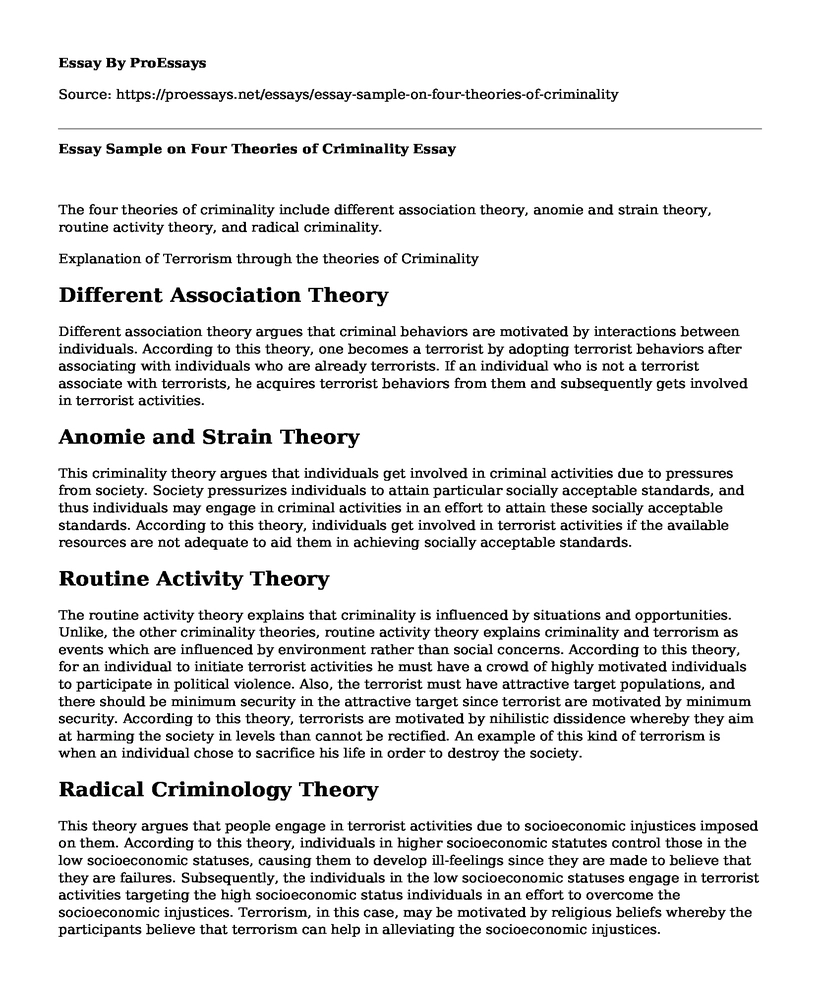The four theories of criminality include different association theory, anomie and strain theory, routine activity theory, and radical criminality.
Explanation of Terrorism through the theories of Criminality
Different Association Theory
Different association theory argues that criminal behaviors are motivated by interactions between individuals. According to this theory, one becomes a terrorist by adopting terrorist behaviors after associating with individuals who are already terrorists. If an individual who is not a terrorist associate with terrorists, he acquires terrorist behaviors from them and subsequently gets involved in terrorist activities.
Anomie and Strain Theory
This criminality theory argues that individuals get involved in criminal activities due to pressures from society. Society pressurizes individuals to attain particular socially acceptable standards, and thus individuals may engage in criminal activities in an effort to attain these socially acceptable standards. According to this theory, individuals get involved in terrorist activities if the available resources are not adequate to aid them in achieving socially acceptable standards.
Routine Activity Theory
The routine activity theory explains that criminality is influenced by situations and opportunities. Unlike, the other criminality theories, routine activity theory explains criminality and terrorism as events which are influenced by environment rather than social concerns. According to this theory, for an individual to initiate terrorist activities he must have a crowd of highly motivated individuals to participate in political violence. Also, the terrorist must have attractive target populations, and there should be minimum security in the attractive target since terrorist are motivated by minimum security. According to this theory, terrorists are motivated by nihilistic dissidence whereby they aim at harming the society in levels than cannot be rectified. An example of this kind of terrorism is when an individual chose to sacrifice his life in order to destroy the society.
Radical Criminology Theory
This theory argues that people engage in terrorist activities due to socioeconomic injustices imposed on them. According to this theory, individuals in higher socioeconomic statutes control those in the low socioeconomic statuses, causing them to develop ill-feelings since they are made to believe that they are failures. Subsequently, the individuals in the low socioeconomic statuses engage in terrorist activities targeting the high socioeconomic status individuals in an effort to overcome the socioeconomic injustices. Terrorism, in this case, may be motivated by religious beliefs whereby the participants believe that terrorism can help in alleviating the socioeconomic injustices.
Differences Between the Four Theories of Criminality in Relation to Terrorism
Different association theory, anomie and strain theory, and radical criminology explain terrorism from a sociological perspective. However, each of the theories explain terrorism differently. Different association theory explains that individuals acquire terrorist behaviors after developing social relations with individuals who are already terrorists. On the other hand, anomie and strain theory explains that society influences terrorist activities by pressuring individuals to achieve certain acceptable standards without providing the necessary resources for achieving those standards. Individuals thus engage in terrorist activities in an effort to attain these society's acceptable standards. Radical criminology theory, on the other hand, explains that society influences terrorist activities through socioeconomic statutes. The existence of socioeconomic statuses influence terrorism by making the low socioeconomic groups develop terrorist behaviors in an effort to prove their worth in the society. Examples of terrorism from radical criminology theory include Black windows (Chechnya) and Freedom Birds (Sri Lanka).
Anomie and strain theory, and radical criminality justifies terrorism through religion because the participants engage in the terrorist activities in an effort to reduce social injustices within the society. The participants thus believe that their terrorist acts help to purify the society from the injustices. Routine activity theory, however, is unique from the rest because it explains terrorism from a political and environmental perspective. Routine activity theory describes terrorism as an event that is determined by environmental processes whereby terrorists are motivated to execute their heinous acts in regions with less security.
Cite this page
Essay Sample on Four Theories of Criminality. (2022, Nov 06). Retrieved from https://proessays.net/essays/essay-sample-on-four-theories-of-criminality
If you are the original author of this essay and no longer wish to have it published on the ProEssays website, please click below to request its removal:
- Paper Example on Increasing Violence towards Police Officers in the US
- Essay Sample on Gender Issues in the Society
- Essay Sample on Sexual Discrimination Lawsuit
- Research Paper Example on Housing for Refugees
- Research Paper on Child Trafficking: Poverty, Neglect & Exploitation
- Morgan Lane Arnold: Too Young for a Life Sentence? - Essay Sample
- Essay Sample on A History of Rights in the US: African-Americans and Women







